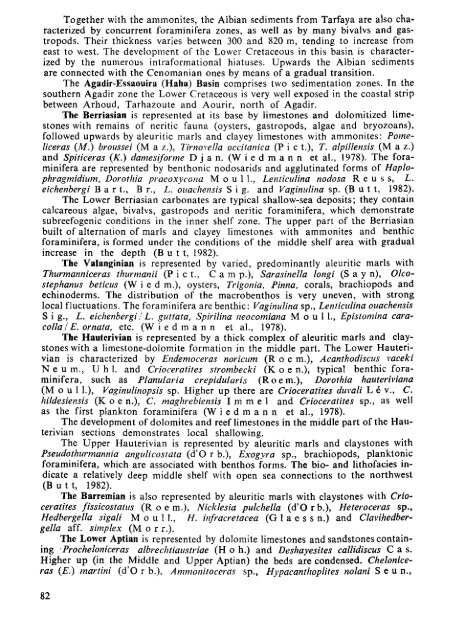THE MEDITERRANEAN LOWER CRETACEOUS
THE MEDITERRANEAN LOWER CRETACEOUS
THE MEDITERRANEAN LOWER CRETACEOUS
Create successful ePaper yourself
Turn your PDF publications into a flip-book with our unique Google optimized e-Paper software.
Together with the ammonites, the Albian sediments from Tarfaya are also characterized<br />
by concurrent foraminifera zones, as well as by many bivalvs and gastropods.<br />
Their thickness varies between 300 and 820 m, tending to increase from<br />
east to west. The development of the Lower Cretaceous in this basin is characterized<br />
by the numerous intraformational hiatuses. Upwards the Albian sediments<br />
are connected with the Cenomanian ones by means of a gradual transition.<br />
The Agadir-Essaouira (Haha) Basin comprises two sedimentation zones. In the<br />
southern Agadir zone the Lower Cretaceous is very well exposed in the coastal strip<br />
between Arhoud, Tarhazoute and Aourir, north of Agadir.<br />
The Berriasian is represented at its base by limestones and dolomitized limestones<br />
with remains of neritic fauna (oysters, gastropods, algae and bryozoans),<br />
followed upwards by aleuritic marls and clayey limestones with ammonites: Pomeliceras<br />
(M.) broussei (M a z.), Tirnovella occitanica (P i с t.), T. alpillensis (M a z.)<br />
and Spiticeras (К.) damesiforme Djan. (Wiedmann et al., 1978). The foraminifera<br />
are represented by benthonic nodosarids and agglutinated forms of Haplophragmidium,<br />
Dorothia praeoxycona M о u 1 1., Lenticulina nodosa R e u s s, L.<br />
eichenbergi Bart., В г., L. ouachensis S i g. and Vaginulina sp. (Butt, 1982).<br />
The Lower Berriasian carbonates are typical shallow-sea deposits; they contain<br />
calcareous algae, bivalvs, gastropods and neritic foraminifera, which demonstrate<br />
subreefogenic conditions in the inner shelf zone. The upper part of the Berriasian<br />
built of alternation of marls and clayey limestones with ammonites and benthic<br />
foraminifera, is formed under the conditions of the middle shelf area with gradual<br />
increase in the depth (Butt, 1982).<br />
The Valanginian is represented by varied, predominantly aleuritic marls with<br />
Thurmanniceras thurmanii (P i с t., Cam p.), Sarasinella longi (Say n), Olcostephanus<br />
beticus (W i e d m.), oysters, Trigonia, Pinna, corals, brachiopods and<br />
echinoderms. The distribution of the macrobenthos is very uneven, with strong<br />
local fluctuations. The foraminifera are benthic: Vaginulina sp., Lenticulina ouachensis<br />
S i g., L. eichenbergi ! L. guttata, Spirilina neocomiana M о u 1 1., Epistomina caracolla<br />
I E. ornata, etc. (Wiedmann et al., 1978).<br />
The Hauterivian is represented by a thick complex of aleuritic marls and claystones<br />
with a limestone-dolomite formation in the middle part. The Lower Hauterivian<br />
is characterized by Endemoceras noricum (Roe m.), Acanthodiscus vaceki<br />
N e u m., U h 1. and Crioceratites strombecki (Кое п.), typical benthic foraminifera,<br />
such as Planularia crepidularis (Roem.), Dorothia hauteriviana<br />
(M о u 1 1.), Vaginulinopsis sp. Higher up there are Crioceratites duvali L é v., C.<br />
hildesiensis (Кое п.), С. maghrebiensis I m m e 1 and Crioceratites sp., as well<br />
as the first plankton foraminifera (Wiedmann et al., 1978).<br />
The development of dolomites and reef limestones in the middle part of the Hauterivian<br />
sections demonstrates local shallowing.<br />
The Upper Hauterivian is represented by aleuritic marls and claystones with<br />
Pseudothurmannia angulicostata (d'O r b.), Exogyra sp., brachiopods, planktonic<br />
foraminifera, which are associated with benthos forms. The bio- and lithofacies indicate<br />
a relatively deep middle shelf with open sea connections to the northwest<br />
(Butt, 1982).<br />
The Barremian is also represented by aleuritic marls with claystones with Crioceratites<br />
fissicostatus (Roem.), Nicklesia pulchella (d'Orb.), Heteroceras sp.,<br />
Hedbergella sigali M о u 1 1., H. infracretacea (G 1 a e s s п.) and Clavihedbergella<br />
aff. simplex (M о г г.).<br />
The Lower Aptian is represented by dolomite limestones and sandstones containing<br />
Procheloniceras albrechtiaustriae (H о h.) and Deshayesites callidiscus Cas.<br />
Higher up (in the Middle and Upper Aptian) the beds are condensed. Cheloniceras<br />
(E.) martini (d'O r b.), Ammonitoceras sp., Hypacanthoplites nolani S e u п.,<br />
82

















